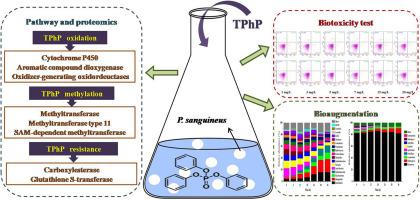Journal of Hazardous Materials ( IF 12.2 ) Pub Date : 2021-05-04 , DOI: 10.1016/j.jhazmat.2021.125983 Mi Feng 1 , Jiahua Zhou 2 , Xiaolong Yu 3 , Hao Wang 2 , Yushuo Guo 2 , Wei Mao 2

|
So far, no information about the biodegradability of TPhP by white rot fungi has previously been made available, herein, Pycnoporus sanguineus was used as the representative to investigate the potential of white rot fungi in TPhP bioremediation. The results suggested that the biodegradation efficiency of 5 mg/L TPhP by P. sanguineus was 62.84% when pH was adjusted to 6 and initial glucose concentration was 5 g/L. Seven biodegradation products were identified, indicating that TPhP was biotransformed through oxidative cleavage, hydroxylation and methylation. The proteomic analysis revealed that cytochrome P450s, aromatic compound dioxygenase, oxidizing species-generating enzymes, methyltransferases and MFS general substrate transporters might occupy important roles in TPhP biotransformation. Carboxylesterase and glutathione S-transferase were induced to resist TPhP stress. The biotreatment by P. sanguineus contributed to a remarkable decrease of TPhP biotoxicity. Bioaugmentation with P. sanguineus could efficiently promote TPhP biodegradation in the water-sediment system due to the cooperation between P. sanguineus and some putative indigenous degraders, including Sphingobium, Burkholderia, Mycobacterium and Methylobacterium. Overall, this study provided the first insights into the degradation pathway, mechanism and security risk assessment of TPhP biodegradation by P. sanguineus and verified the feasibility of utilizing this fungus for TPhP bioremediation applications.
中文翻译:

碧萝P(Pycnoporus sanguineus)对磷酸三苯酯的生物修复:代谢途径,蛋白质组学机理和生物毒性评估
迄今为止,以前尚未获得有关白腐真菌对TPhP的生物降解性的信息,在此,以Pycnoporus sanguineus为代表,研究了白腐真菌在TPhP生物修复中的潜力。结果表明,血红假单胞菌对5 mg / L TPhP的生物降解效率。当pH调节至6且初始葡萄糖浓度为5g / L时,其为62.84%。鉴定出七个生物降解产物,表明TPhP是通过氧化裂解,羟基化和甲基化而生物转化的。蛋白质组学分析表明,细胞色素P450,芳香族化合物双加氧酶,氧化性物种生成酶,甲基转移酶和MFS通用底物转运蛋白可能在TPhP生物转化中发挥重要作用。诱导羧基酯酶和谷胱甘肽S-转移酶抵抗TPhP胁迫。血红假单胞菌的生物处理大大降低了TPhP的生物毒性。血红假单胞菌的生物强化由于血红假单胞菌和某些假定的本地降解菌(包括鞘氨醇,伯克霍尔德氏菌,分枝杆菌和甲基细菌)之间的合作,可以有效地促进水-沉积系统中TPhP的生物降解。总体而言,这一研究提供了第一个洞察到由TPhP生物降解的降解途径,机制和安全风险评估P.蜱和核实利用这种真菌的生物修复TPhP应用的可行性。









































 京公网安备 11010802027423号
京公网安备 11010802027423号